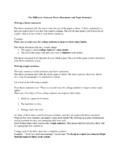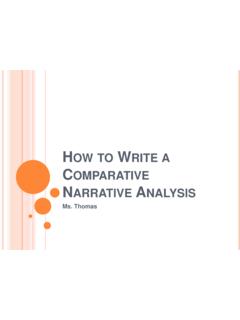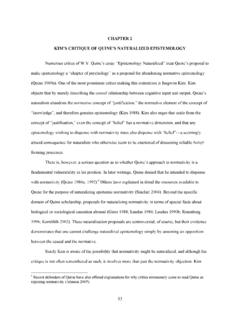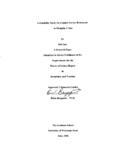Transcription of NAVAL POSTGRADUATE SCHOOL
1 NAVAL POSTGRADUATE SCHOOL MONTEREY, CALIFORNIA thesis Approved for public release; distribution is unlimited AN ANALYSIS OF THE KILL CHAIN FOR TIME- CRITICAL STRIKE by William K. Brickner June 2005 thesis Advisor: Patricia A. Jacobs thesis Co-Advisor: Donald P. Gaver Second Reader: Albert J. DeSanti THIS PAGE INTENTIONALLY LEFT BLANK i REPORT DOCUMENTATION PAGE Form Approved OMB No. 0704-0188 Public reporting burden for this collection of information is estimated to average 1 hour per response, including the time for reviewing instruction, searching existing data sources, gathering and maintaining the data needed, and completing and reviewing the collection of information. Send comments regarding this burden estimate or any other aspect of this collection of information, including suggestions for reducing this burden, to Washington headquarters Services, Directorate for Information Operations and Reports, 1215 Jefferson Davis Highway, Suite 1204, Arlington, VA 22202-4302, and to the Office of Management and Budget, Paperwork Reduction Project (0704-0188) Washington DC 20503.
2 1. AGENCY USE ONLY (Leave blank) 2. REPORT DATE June 2005 3. REPORT TYPE AND DATES COVERED Master s thesis 4. TITLE AND SUBTITLE: An Analysis of the Kill Chain for Time-Critical Strike 6. AUTHOR(S) William K. Brickner 5. FUNDING NUMBERS 7. PERFORMING ORGANIZATION NAME(S) AND ADDRESS(ES) NAVAL POSTGRADUATE SCHOOL Monterey, CA 93943-5000 8. PERFORMING ORGANIZATION REPORT NUMBER 9. SPONSORING /MONITORING AGENCY NAME(S) AND ADDRESS(ES) NAVAL Air Systems Command (NAVAIR) Center for Defense Technology and Education for the Military Services Initiative (CDTEMS) Battlespace Communications Architecture project of the Cebrowski Institute, NAVAL POSTGRADUATE SCHOOL , Monterey CA 93943 10. SPONSORING/MONITORING AGENCY REPORT NUMBER 11. SUPPLEMENTARY NOTES The views expressed in this thesis are those of the author and do not reflect the official policy or position of the Department of Defense or the Government.
3 12a. DISTRIBUTION / AVAILABILITY STATEMENT Approved for public release; distribution is unlimited 12b. DISTRIBUTION CODE 13. ABSTRACT (maximum 200 words) The detection and destruction of Time-Critical Targets (TCTs) has been a challenge for our military. NAVAIR has investigated a future time-critical strike (TCS) architecture and concept of operations (CONOPS) in order to explore the effectiveness of high-speed weapons against TCTs. NAVAIR has implemented a architecture and CONOPS in a simulation model. This thesis extends NAVAIR s work by developing flexible models and exploring the effects that alternative CONOPS may have on high-speed weapon requirements and system performance against TCTs. The TCTs are a single wave of theater ballistic missile (TBM) transporter-erector-launchers (TELs) that appear over a short time interval and can saturate the command and control architectures considered.
4 For the architecture and alternative CONOPS explored, it is difficult to improve upon the performance of the baseline TCS system developed by NAVAIR. 15. NUMBER OF PAGES 127 14. SUBJECT TERMS time-sensitive strike, time-critical strike, simulation, queueing, high-speed weapons, kill chain 16. PRICE CODE 17. SECURITY CLASSIFICATION OF REPORT Unclassified 18. SECURITY CLASSIFICATION OF THIS PAGE Unclassified 19. SECURITY CLASSIFICATION OF ABSTRACT Unclassified 20. LIMITATION OF ABSTRACT UL NSN 7540-01-280-5500 Standard Form 298 (Rev. 2-89) Prescribed by ANSI Std. 239-18 ii THIS PAGE INTENTIONALLY LEFT BLANK iiiApproved for public release; distribution is unlimited AN ANALYSIS OF THE KILL CHAIN FOR TIME CRITICAL STRIKE William K. Brickner NAVAL Air Warfare Center, Weapons Division, China Lake , Actuarial Studies/Mathematics, Thiel College, 1996 Submitted in partial fulfillment of the requirements for the degree of MASTER OF SCIENCE IN OPERATIONS RESEARCH from the NAVAL POSTGRADUATE SCHOOL June 2005 Author: William K.
5 Brickner Approved by: Patricia A. Jacobs thesis Advisor Donald P. Gaver Co-Advisor Albert J. DeSanti Second Reader James N. Eagle Chairman, Department of Operations Research iv THIS PAGE INTENTIONALLY LEFT BLANK vABSTRACT Because of their limited window of vulnerability, the detection and destruction of Time-Critical Targets (TCTs) has been a significant challenge for our military forces. The NAVAL Air Systems Command (NAVAIR) has investigated a future time-critical strike (TCS) architecture and concept of operations (CONOPS) in order to explore the effectiveness of high-speed weapons against TCTs. NAVAIR has represented the network-centric architecture and CONOPS in a simulation model. This thesis extends NAVAIR s work by developing flexible simulation models and exploring the effects that alternative CONOPS and technology enhancements may have on high-speed weapon requirements and overall system performance against TCTs.
6 The TCTs are a single wave of theater ballistic missile (TBM) transporter-erector-launchers (TELs) appearing over a short time interval. The wave of TBM TELS can saturate the command and control architectures considered. The CONOPS is to use weapons with the shortest fly-out times first. For the architecture and alternative CONOPS explored, it is difficult to improve upon the performance of the baseline TCS system developed by NAVAIR. vi THIS PAGE INTENTIONALLY LEFT BLANK viiTABLE OF CONTENTS I. INTRODUCTION ..1 A. BACKGROUND ..2 B. OBJECTIVE AND SCOPE OF THIS thesis ..3 II. TCS ARCHITECTURE AND CONOPS ..5 A. THE KILL CHAIN ..5 B. INTRODUCTION TO MAJOR SUB-SYSTEMS ..5 1. Ground Moving Target Indicator (GMTI) Radar ..6 2.
7 Synthetic Aperture Radar (SAR) ..6 3. Digital Point-Positioning Database (DPPDB) ..7 4. High-Speed Weapons ..7 C. SCENARIO AND ASSUMPTIONS ..8 D. BASELINE BLUE CONOPS ..9 E. ALTERNATIVE CONOPS AND TRACK-WHILE-SCAN CAPABILITY ..11 1. Track-While-Scan ISR Capability ..11 2. Updating ..12 3. Alternative Queueing Disciplines ..13 a. Last-in, First Out (LIFO) ..14 b. Prioritizing TELs by Type ..14 III. SIMULATION METHODOLOGY ..15 A. THE EXTEND SOFTWARE PACKAGE ..15 1. Introduction ..15 2. Random Numbers ..15 B. DEVELOPMENT OF MODELS ..16 C. PARAMETERS ..17 1. Parameters Obtained from NAVAIR ..17 2. TEL Dwell Times ..17 D. VARIANCE REDUCTION: COMMON RANDOM NUMBERS ..18 E. IMPLEMENTATION OF THE TCS ARCHITECTURE AND CONOPS .19 1. GMTI Implementation ..19 2. SAR Implementation ..20 3. Weapon Flight Times ..23 4. TEL Arrival processes.
8 23 a. Coordinated Launch ..23 b. Coordinated Stop ..24 5. Track-While-Scan ..24 6. Updating ..25 IV. ANALYSIS ..27 A. ORGANIZATION AND METHODOLOGY ..27 B. MEASURES OF EFFECTIVENESS (MOE) ..28 viiiC. COMPARING MODELS: THE PAIRED-T CONFIDENCE INTERVAL ..29 D. VERIFICATION OF THE BASELINE MODEL ..31 1. Approach ..31 2. Verification Results ..32 E. COORDINATED TBM LAUNCHES ..33 1. Results for the Baseline Architecture and CONOPS ..33 2. Track-while-scan Results ..37 3. LIFO Analyst Queue ..41 4. Updating ..43 a. Mean Number of TELs Engaged Prior to Dwell Time Completion ..43 b. Mean Number of Weapons Expended ..44 5. Priority Queues ..46 a. Prioritize on Medium-Dwell TELs ..48 b. Prioritize on Long-Dwell TELs ..50 F. COORDINATED TEL STOP TIMES ..51 1. Results for the Baseline Architecture and CONOPS ..51 2.
9 Track-while-scan Results ..52 3. LIFO Analyst Queue ..54 4. Updating ..54 a. Mean Number of TELs Engaged Prior to Dwell Time Completion ..55 b. Mean Number of Weapons Expended ..55 5. Priority Queues ..57 a. New Baseline (All Queues FCFS) ..57 b. Prioritize on Medium-Dwell TELs ..57 c. Prioritize on Long-Dwell TELs ..57 G. DISCUSSION ..58 1. Sensitivity of the Results to the Standard Deviation of TEL Dwell Times ..58 2. Sensitivity of the Results to the TEL Arrival Processes ..69 3. Sensitivity of the Results to the Shooter Selection Policy ..70 4. Congestion in the TCS Architecture ..72 V. CONCLUSIONS AND RECOMMENDATIONS ..75 A. CONCLUSIONS ..75 B. RECOMMENDATIONS FOR FOLLOW-UP RESEARCH ..77 APPENDIX A. OMMITTED ANALYSIS TABLES ..79 APPENDIX B. MEANS, STANDARD DEVIATIONS, AND 95 PERCENT CONFIDENCE INTERVALS FOR FIGURES.
10 83 ixAPPENDIX C. EXTRA IMAGE ANALYST RESULTS ..89 APPENDIX D. ORDER STATISTICS ..93 LIST OF REFERENCES ..95 INITIAL DISTRIBUTION LIST ..97 x THIS PAGE INTENTIONALLY LEFT BLANK xiLIST OF FIGURES Figure 1. Kill Chain Elements and Associated TCS Timeline Goals (derived from reference 5) ..5 Figure 2. Extend Desktop. Blocks are dragged onto the desktop and connected to produce a model..16 Figure 3. Event Graph for the Baseline TCS Architecture..19 Figure 4. Time to Detect a Stopped TEL. The blocks labeled one through six represent the GMTI sensor bands. In this case, the TEL stops after the sensor has passed over its location during the current GMTI scan..22 Figure 5. Baseline Model Mean Processing and Weapon Fly-Out Times for Coordinated TBM Launches. The estimates are based on 30 simulation replications of 45 medium-dwell TELs, each having a lognormal(20,5) dwell time distribution.














